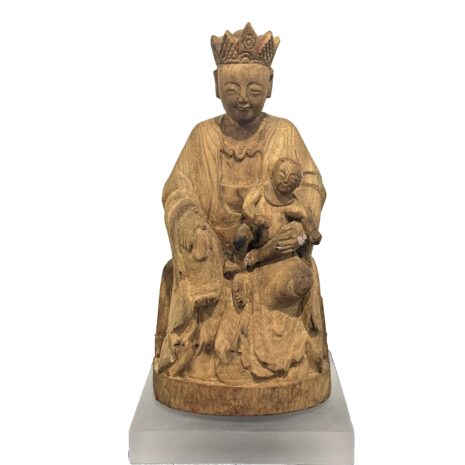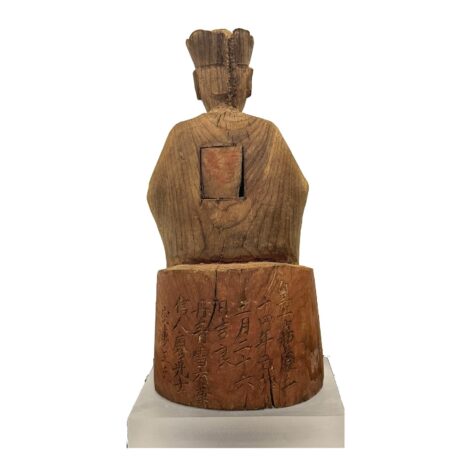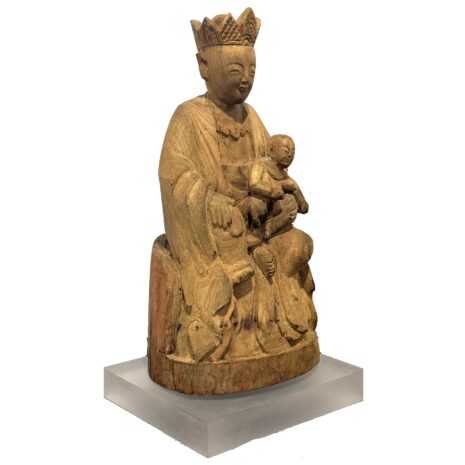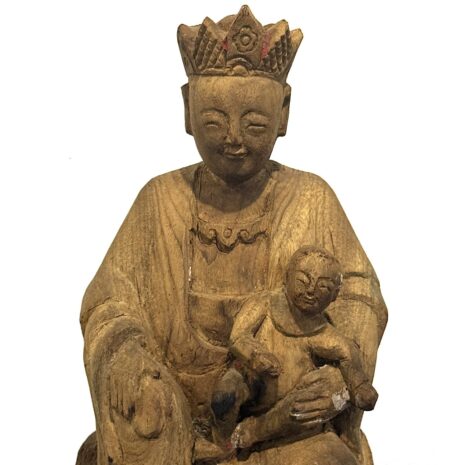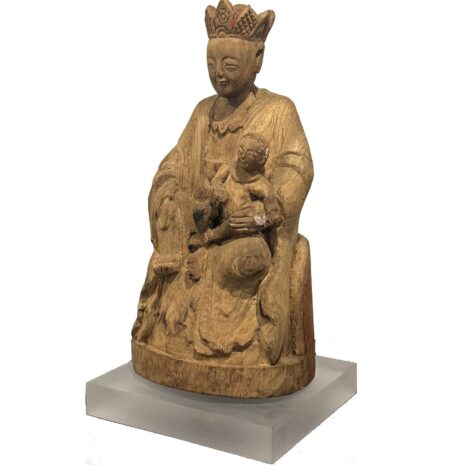Ming Guanyin, Bestower of Children, China (16057)
Original price was: $1,350.00.$1,100.00Current price is: $1,100.00.
H: 11” W: 5.75” D: 5.125” | FREE SHIPPING WITHIN CONTINENTAL U.S.
Very rare and fine 16th century home shrine image with compassionate countenance of Songzi Guanyin the “Bestower of Children.” With joyful half-closed eyes, she looks lovingly at the child whose arm is draped over hers.and leans slightly forward.Wearing a 5- lobed crown centered with a camellia flower a Chinese symbol of young sons and daughters. Inscription dates it to 1521-1567
Description
Songzi Guanyin (Bestower of Children or Child-giving) was one of the most favored Guanyin manifestation during the Ming and Qing dynasties when small images were placed on a home altar for veneration by families desirous of having a male child to carry on the family legacy. Songzi Guanyin is embraced in Buddhism, Taoism and Popular Religion and especially by women who sought salvation in her compassion that extended to all people regardless of status, a characteristic of the Great Chinese Goddesses (Irvin). In Mahayana Buddhism, she was portrayed as a female in accordance with Confucian beliefs that women should seek comfort and solace only from a female deity, especially regarding requests for children, protection of the mother and child during child birth and for protection after birth.
Initially, Child-giving Guanyin was not depicted holding a child, but during the 16–18th centuries, missionaries and Jesuits commissioned Chinese artisans to fashion images of the Madonna and Child, and images of Child Giving Guanyin subsequently became similar to the Virgin Mary holding the baby Jesus. Portrayed as a maternal figure with a male baby, her power to grant children is described in the Lotus Sutra, Chapter 25, which states… A woman desiring a son, “…after making worshipful offerings to the bodhisattva (Guanyin) shall straightway bare a son of happiness, excellence and wisdom. If she be desirous… of having a daughter, she shall straightway bare a daughter, upright and endowed with proper marks, who is loved and honored by a multitude of men.”
This antique carving was commissioned by a Guanyin devotee for personal veneration to assist a couple in the pregnancy, birth and delivery of a healthy male child.leans slightly forward, with delicate facial features with a sweet smile, wears a 5- lobed crown centered with a camellia flower a Chinese symbol of young sons and daughters. With round face and joyful half-closed and eyes, she looks lovingly at the child whose arm is draped over hers. The closed rear cavity (bung) indicates it was consecrated when its long inscription on the back was made, “On the auspicious day of March 26 during the 24th year of the reign of the emperor Chia-Ching, Guang Shi Liao, the student of master Lei Yuhua, admires the master’s work and had this piece made to honor his wife Guang Shi Liao.” Chia-Ching (Gia Jiang) reigned from was 1521-1567, making the creation of this piece March 1544. It was originally covered with a white base and painted in polychrome indicated by small white traces and the red touches in the crown. Although the polychrome was removed revealing a bare surface that shows the subtleties and brilliance of the details of this fine woodcarving, it is in very good condition for its age and use.
Click here for the Blog Consecrating Wooden Images to Imbue Them with A Life Force
Source:
Lee Irwin, “Divinity and Salvation: The Great Goddesses of China,” in Asian Folklore Studies, Indiana University, Vol. 49, 1990, pp 53-68.
Additional information
| Weight | 5 lbs |
|---|---|
| Dimensions | 16 × 12 × 8 in |
| Place of Origin | China |
| Period | Antique, Ming Dynasty |
| Date | 16th century |
| Materials and Technique | Wood |
| Dimensions (inches) | Ht: 11" W: 5.75" D: 5.125" |
| Dimensions (metric) | Ht: 27.94cm W: 14.60cm D: 13.02cm |
| Weight | 2lbs |
| Condition | Very Good, expected signs of age and use. |
| Item Number | 16075BME |
| Shipping Box Size |

